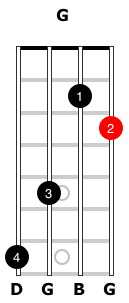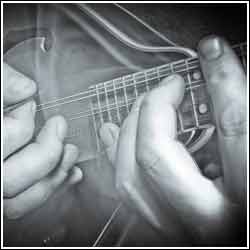
Moveable chords are a great way to expand your chord vocabulary on the mandolin. Thus opening up the fingerboard and enabling you to figure out many different chords. It can also help you to gain access to almost any key.
Any chord, or shape on the fingerboard can be made into a moveable chord as long as you understand where the root is, and you don’t play any open strings. However, there are a few popular moveable chords and shapes that we can take a look at.
Every chord is named after its root note. In the following diagrams, the root note is indicated in red.
Moveable Chords – Shape 1
For discussion purposes, we’ll call this chord shape the “A-style”.
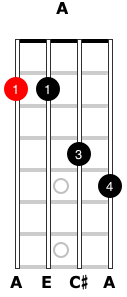
As you can see, the root note for this chord shape is on the 4th string (the G string) of the mandolin.
If we place this chord on the fingerboard with our index finger (the red dot) on the second fret of the G-string, we get an “A” chord (as seen in the diagram) because the second fret of the 4th string is an “A” note.
So, the notes on the 4th string (the G-string) define, or name our chord.
Therefore, you can move the shape up and down the neck, naming the resulting chord after note fretted on the 4th string. If we move the whole shape down a fret, so that our index finger (the red dot) is on the first fret of the G-string, we’d have an “Ab” chord (or a “G#”). Also, if we slide it up so that the root is on the 3rd fret of the G-string, we get an “A#” (or a “Bb”).
• 4th fret – “B”
• 5th fret – “C”
• 6th fret – “C#” or “Db”
• 7th fret – “D”
• 8th fret – “D#” or “Eb”
• 9th fret – “E”
• etc…
Variations to the “A-style” moveable chord
- A basic chord consists of the first (root), third and fifth of the scale.
- To get a minor chord we flat the third.
- We add a flatted 7th note to get a 7th chord (dominant 7th).
- If we want a minor 7th, then we flat the 3rd and add a flatted 7th.
- For a major 7th , we add the 7th note of the scale to the basic triad.
Each variation can be moved up or down the neck!
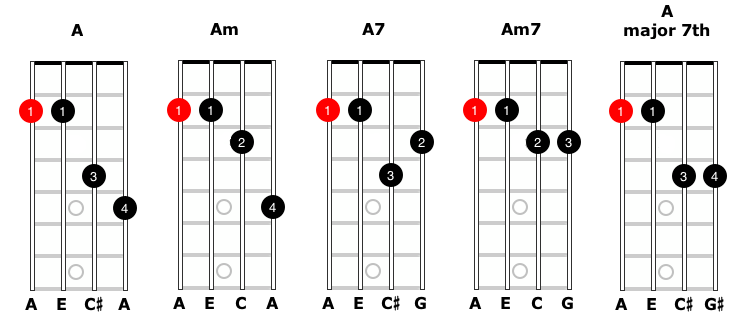
Moveable Chords – Shape 2
For discussion purposes, we’ll call this chord shape the “E-style”.
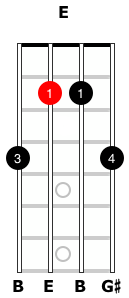
As you can see, the root note for this chord shape is on the 3rd string (the D string). If we place this chord on the fingerboard with our index finger (the red dot) on the second fret of the D-string, we get an “E” chord.
With this shape, the notes on the 3rd string (D-string) define, or name the chord.
If we move the whole shape down a fret, so that our index finger (the red dot) is on the first fret of the D-string, then we’ll have an “Eb” chord (or a “D#”). By sliding it up, so that the root is on the 3rd fret of the D-string, we get an “F”.
• 4th fret – “F#” or “Gb”
• 5th fret – “G”
• 6th fret – “G#” or “Ab”
• 7th fret – “A”
• 8th fret – “A#” or “Bb”
• 9th fret – “B”
• etc…
Variations
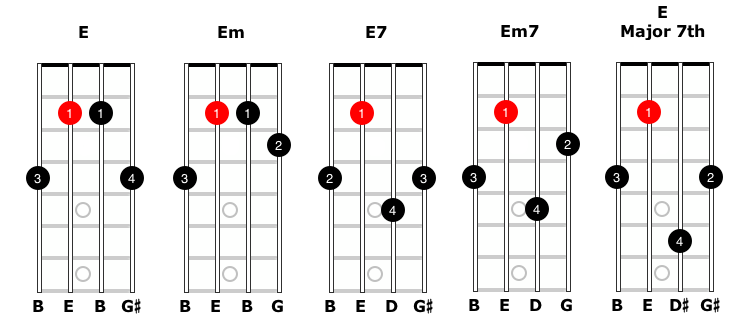
Moveable Chords – Shape 3
We’ll call this shape the “D-style” moveable chord.
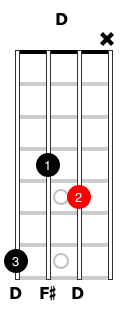
As you can see, the root note for this chord shape is under our middle finger, on the 2nd string (the A string). As a result, the chord is named by the notes on the 2nd (A) string. If we place this chord on the fingerboard with our middle finger (the red dot) on the 5th fret of the A-string, then we get a “D” chord.
With this chord shape, the notes on the 2nd string define, or name our chord. We don’t usually want the 1st string to sound, so we try to mute the 1st string with the fleshy part of our index finger.
If we move this shape down 2 frets, so that our middle finger (the red dot) is on the third fret of the A-string, this will result in a “C” chord. If we slide it up one fret from there, so that the root is on the 4th fret of the A-string we end up with a “C#” (or a “Db”).
• 5th fret – “D”
• 6th fret – “D#” or “Eb”
• 7th fret – “E”
• 8th fret – “F”
• 9th fret – “F#” or “Gb”
• 10th fret – “G”
• etc…
D-style Variations
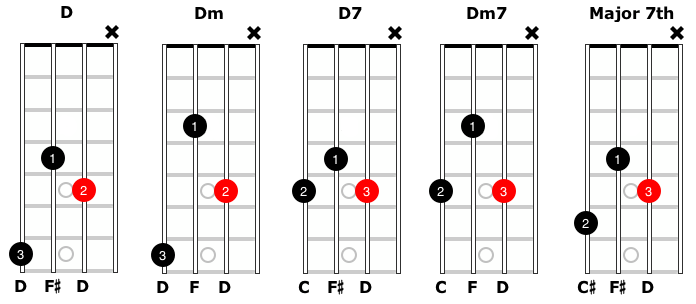
Here is another variation. It’s a bit of a stretch for the fingers, but it frets the 1st string. Because its used as a chop chord, it’s one you should work on.
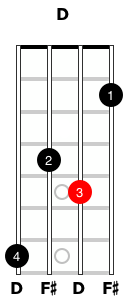
Moveable Chords – Shape 4
We’ll refer to the next chord shape as the “G-style”.
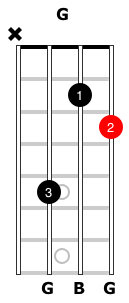
As you can see, the root note for this chord shape is under our middle finger, on the 1st string (the E string). So, if we place this moveable shape on the fingerboard with our middle finger (the red dot) on the 3rd fret of the E-string, we get a “G” chord.
Because the root is on the “E-string”, the notes on the 1st string define, or name the chord.
We don’t usually want the 4th string to sound, so we try to mute the 4th string with the fleshy part at the base of the thumb.
Moving the shape down a fret, so that our middle finger (the red dot) is on the second fret of the E-string, results in a “Gb” chord. Also, if we slide it up so that the root is on the 4th fret of the E-string we get an “G#” or “Ab”.
• 5th fret – “A”
• 6th fret – “A#” or “Bb”
• 7th fret – “B”
• 8th fret – “C”
• 9th fret – “C#” or “Db”
• 10th fret – “D”
• etc…
G-style Variations
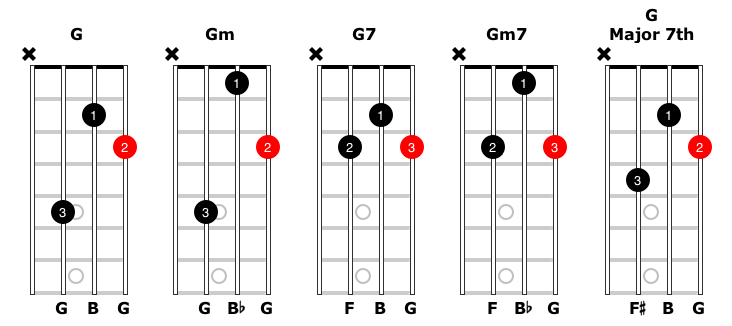
Here is another variation that frets the 4th string. This is the common “G-style” chop chord and it’s definitely one you should learn.
